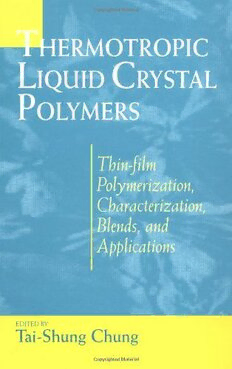
Thermotropic Liquid Crystal Polymers: Thin-film Poly Chara Blends PDF
358 Pages·2001·6.782 MB·English
Most books are stored in the elastic cloud where traffic is expensive. For this reason, we have a limit on daily download.
Preview Thermotropic Liquid Crystal Polymers: Thin-film Poly Chara Blends
Description:
Liquid crystal polymers are sometimes called super polymers--with good reason. Their wide range of exceptional properties and ease of processing make them design candidates for many demanding applications. This new book provides a thorough review of LCP technology with the emphasis on the chemistry, synthesis and characterization of the material in its many variants. Additional chapters cover processing and applications. From the Editor's PrefaceThe field of thermotropic liquid crystalline polymers has grown substantially in the last two decades, with fundamental research, publications, commercial products, and patents. In the 1980's, Dr. Ralph Miano led my colleagues and me at Hoechst Celanese in commercializing the first thermotropic liquid crystalline polymers, based on Dr. Gordon Calundann's composition patents. Today, more than seven companies have produced thermotropic liquid crystalline polymer materials, with at least 50 variants available. Hence, it is timely to compile a comprehensive review on the nature of this type of material and the ongoing progress in this field…. The goals of this book are to summarize previous work, provide new insights into this class of polymers, and add to the understanding of the formation of liquid crystallinity. This book covers a wide range of topics and addresses different disciplines in the field. The chapters are arranged as a learning scheme for the professional, from basic science to applied engineering. The first few chapters summarize the syntheses of various polyester, polyester-amid, and polyimide liquid crystalline polymers. The science and origins of liquid crystal formation are revealed. Next, we introduce the characterizations of these materials by their different chemical and physical aspects.Because most commercially available thermotropic liquid crystalline polymers have been used in the form of composites, we have also incorporated a chapter on polymer blends, detailing blending mechanisms and resultant properties. Two chapters on thermosetting liquid crystalline polymers integrate them with other topics, because of their unique importance and their applications for microelectronics and packaging. The final chapter deals with the engineering and processing aspects of thermoplastic liquid crystalline polymers for a variety of applications.
See more
The list of books you might like
Most books are stored in the elastic cloud where traffic is expensive. For this reason, we have a limit on daily download.
